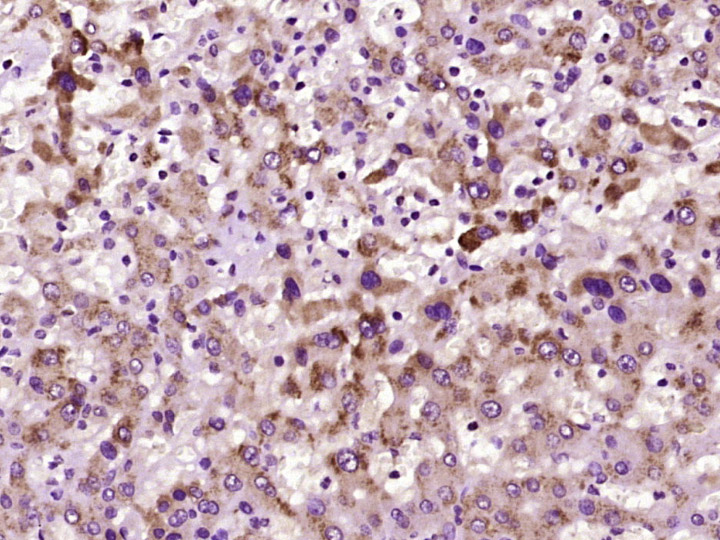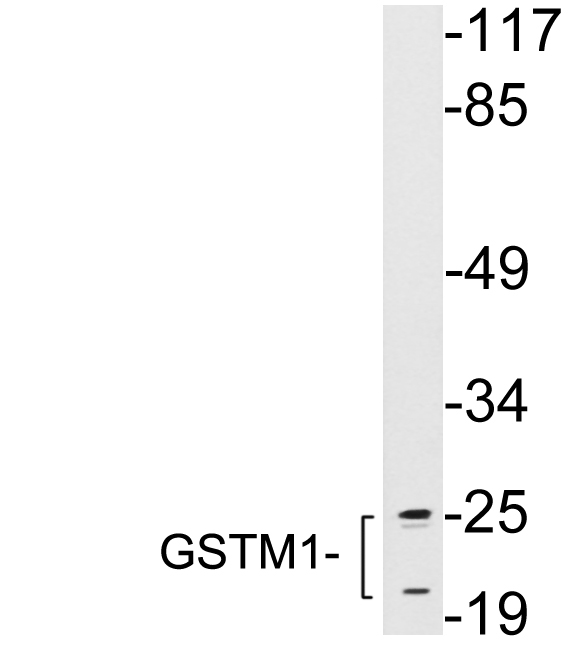GSTM1 antibody
GTX113448
ApplicationsWestern Blot, ImmunoHistoChemistry, ImmunoHistoChemistry Paraffin
Product group Antibodies
ReactivityHuman, Mouse, Rat
TargetGSTM1
Overview
- SupplierGeneTex
- Product NameGSTM1 antibody
- Delivery Days Customer9
- Application Supplier NoteWB: 1:500-1:3000. IHC-P: 1:100-1:1000. *Optimal dilutions/concentrations should be determined by the researcher.Not tested in other applications.
- ApplicationsWestern Blot, ImmunoHistoChemistry, ImmunoHistoChemistry Paraffin
- CertificationResearch Use Only
- ClonalityPolyclonal
- Concentration1 mg/ml
- ConjugateUnconjugated
- Gene ID2944
- Target nameGSTM1
- Target descriptionglutathione S-transferase mu 1
- Target synonymsGST1, GSTM1-1, GSTM1a-1a, GSTM1b-1b, GTH4, GTM1, H-B, MU, MU-1, glutathione S-transferase Mu 1, GST HB subunit 4, GST class-mu 1, HB subunit 4, S-(hydroxyalkyl)glutathione lyase, glutathione S-alkyltransferase, glutathione S-aralkyltransferase, glutathione S-aryltransferase, glutathione S-transferase M1
- HostRabbit
- IsotypeIgG
- Protein IDP09488
- Protein NameGlutathione S-transferase Mu 1
- Scientific DescriptionCytosolic and membrane-bound forms of glutathione S-transferase are encoded by two distinct supergene families. At present, eight distinct classes of the soluble cytoplasmic mammalian glutathione S-transferases have been identified: alpha, kappa, mu, omega, pi, sigma, theta and zeta. This gene encodes a glutathione S-transferase that belongs to the mu class. The mu class of enzymes functions in the detoxification of electrophilic compounds, including carcinogens, therapeutic drugs, environmental toxins and products of oxidative stress, by conjugation with glutathione. The genes encoding the mu class of enzymes are organized in a gene cluster on chromosome 1p13.3 and are known to be highly polymorphic. These genetic variations can change an individuals susceptibility to carcinogens and toxins as well as affect the toxicity and efficacy of certain drugs. Null mutations of this class mu gene have been linked with an increase in a number of cancers, likely due to an increased susceptibility to environmental toxins and carcinogens. Multiple protein isoforms are encoded by transcript variants of this gene. [provided by RefSeq]
- ReactivityHuman, Mouse, Rat
- Storage Instruction-20°C or -80°C,2°C to 8°C
- UNSPSC12352203
References
- Zamami Y, Niimura T, Kawashiri T, et al. Identification of prophylactic drugs for oxaliplatin-induced peripheral neuropathy using big data. Biomed Pharmacother. 2022,148:112744. doi: 10.1016/j.biopha.2022.112744Read this paper
- Dai YC, Wang SC, Haque MM, et al. The interaction of arsenic and N-butyl-N-(4-hydroxybutyl)nitrosamine on urothelial carcinogenesis in mice. PLoS One. 2017,12(10):e0186214. doi: 10.1371/journal.pone.0186214Read this paper
- Wang SC, Huang CC, Shen CH, et al. Gene Expression and DNA Methylation Status of Glutathione S-Transferase Mu1 and Mu5 in Urothelial Carcinoma. PLoS One. 2016,11(7):e0159102. doi: 10.1371/journal.pone.0159102Read this paper
- Gdula-Argasińska J, Czepiel J, Totoń-Żurańska J, et al. Resolvin D1 down-regulates CYP1A1 and PTGS2 gene in the HUVEC cells treated with benzo(a)pyrene. Pharmacol Rep. 2016,68(5):939-44. doi: 10.1016/j.pharep.2016.05.005Read this paper
- Chuang JJ, Dai YC, Lin YL, et al. Downregulation of glutathione S-transferase M1 protein in N-butyl-N-(4-hydroxybutyl)nitrosamine-induced mouse bladder carcinogenesis. Toxicol Appl Pharmacol. 2014,279(3):322-330. doi: 10.1016/j.taap.2014.06.018Read this paper






![ELISA analysis of antigen using GTX60526 GSTM1 antibody [1H4A4]. Black : Control antigen 100ng Purple : Antigen 10ng Blue : Antigen 50ng Red : Antigen 100ng](https://www.genetex.com/upload/website/prouct_img/normal/GTX60526/GTX60526_20170912_ELISA_w_23061123_437.webp)
![ELISA analysis of antigen using GTX60527 GSTM1 antibody [1H4F2]. Black : Control antigen 100ng Purple : Antigen 10ng Blue : Antigen 50ng Red : Antigen 100ng](https://www.genetex.com/upload/website/prouct_img/normal/GTX60527/GTX60527_20170912_ELISA_w_23061123_724.webp)